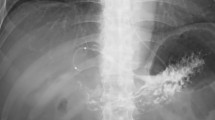Abstract
A 64-year-old woman with unresectable pancreatic body carcinoma was admitted with epigastralgia with a sudden onset 6 h earlier. She had received chemotherapy for her cancer for 2 months. Physical examination showed mild anemia. Contrast-enhanced computed tomography showed dilated vessels in the bile duct walls connecting with dilated and tortuous vessels around the extrahepatic bile duct and portal vein obstruction due to invasion by a pancreatic body tumor. Endoscopic examination showed transpapillary hemorrhage suggesting bile duct hemorrhage. On endoscopic retrograde cholangiopancreatography, the lower bile duct was filled with a mass and the middle bile duct had filling defects with compression of the wall. To stop the bleeding, we placed a fully covered expandable metallic stent (EMS) at the middle to lower portion of the bile duct, and the hemorrhage stopped. Bile duct hemorrhage is not a common disorder. This report shows bile duct hemorrhage from bile duct varices can occur in patients with pancreatic carcinoma with portal obstruction and that fully covered EMS placement can stop the hemorrhage.





Similar content being viewed by others
References
Cvetkovski B, Kurtz RC. Hemobilia in advanced pancreatic cancer with portal vain obstruction and a metal endobiliary stent: a case report. Gastrointest Endosc. 1999;50:420–2.
Chow L, Jeffrey Jr RB. Intramural varices of the bile duct: an unusual pattern of cavernous transformation of the portal vein. Am J Roentgenol. 1999;173:1255–6.
Itoi T, Yasuda I, Doi S, Mukai T, Kurihara T, Sofuni A. Endoscopic hemostasis using covered metallic stent placement for uncontrolled post-endoscopic sphincterotomy bleeding. Endoscopy. 2011;43:369–72.
Williams SM, Burnett DA, Mazer MJ. Radiographic demonstration of common bile duct varices. Gastrointest Radiol. 1982;7:69–70.
Song MH, Kim MH, Lee SK, Lee SS, Seo DW. Bile duct varices. Gastrointest Endosc. 2004;59:869–70.
Bayraktar Y, Balkanci F, Kayhan B, Arslan S, Koseoglu T, Ozdemir A, et al. Bile duct varices or “pseudo-cholangiocarcinoma sign” in portal hypertension due to cavernous transformation of the portal vein. Am J Gastroenterol. 1992;87:1801–6.
Ikegami T, Matsuzaki Y, Saito Y, Nishi M, Tanaka N, Osuga T, et al. Endoscopic diagnosis of common bile duct varices by percutaneous trans-hepatic choledochoscopy: differential diagnosis from bile duct carcinoma. Gastrointest Endosc. 1994;40:637–40.
Tighe M, Jacobson I. Bleeding from bile duct varices: an unexpected hazard during therapeutic ERCP. Gastrointest Endosc. 1996;43:250–2.
Ito T, Segawa T, Kanematsu T. Successful endoscopic injection sclerotherapy for bleeding from bile duct varices. Surg Today. 1997;27:174–6.
Hubmann R, Bodlaj G, Czompo M, et al. The use of self-expanding metal stent to treat acute esophageal variceal bleeding. Endoscopy. 2006;38:896–901.
Gorgul A, Kayhan B, Dogan I, Unal S. Disappearance of the pseudo-cholangiocarcinoma sign after TIPPS. Am J Gastroenterol. 1996;91:150–3.
Conflict of interest
The authors declare that they have no conflict of interest.
Author information
Authors and Affiliations
Corresponding author
Rights and permissions
About this article
Cite this article
Ueda, C., Kikuyama, M., Ueda, T. et al. Hemorrhage from bile duct varices treated with fully covered expandable metallic stent placement in pancreatic carcinoma. Clin J Gastroenterol 6, 80–83 (2013). https://doi.org/10.1007/s12328-012-0354-x
Received:
Accepted:
Published:
Issue Date:
DOI: https://doi.org/10.1007/s12328-012-0354-x




